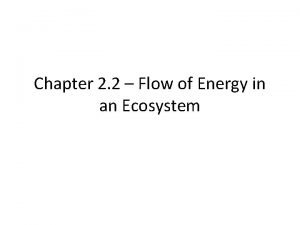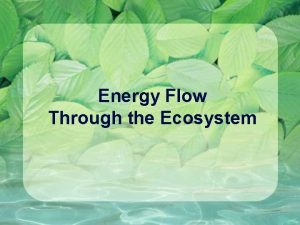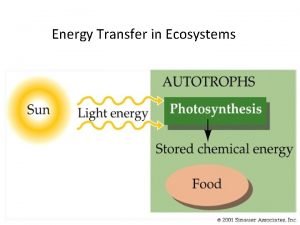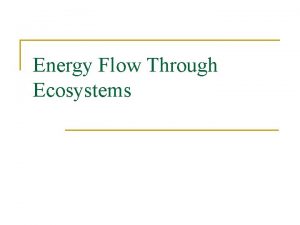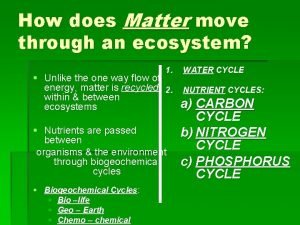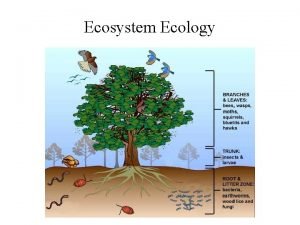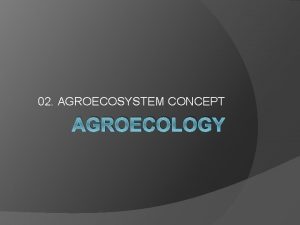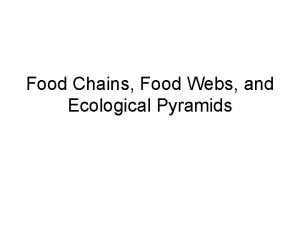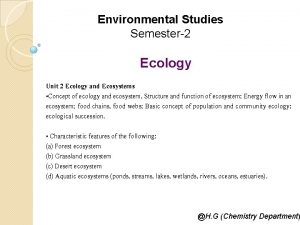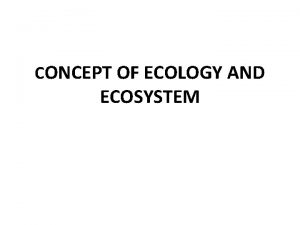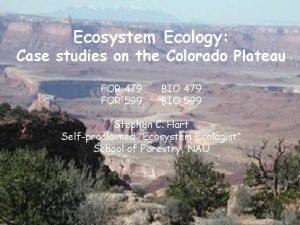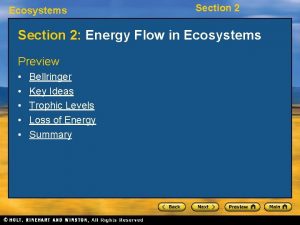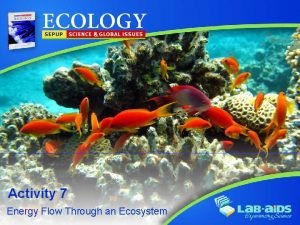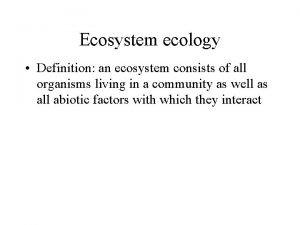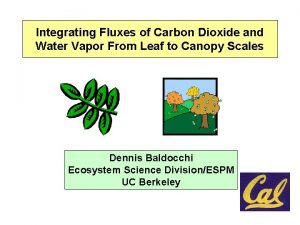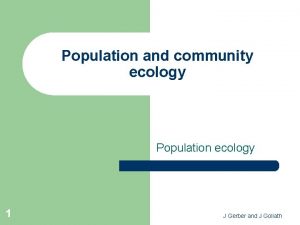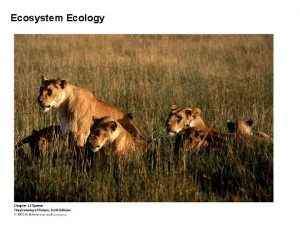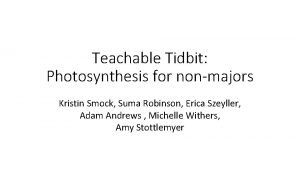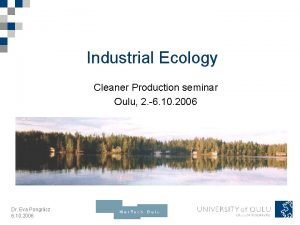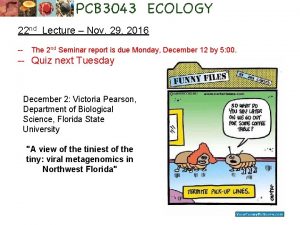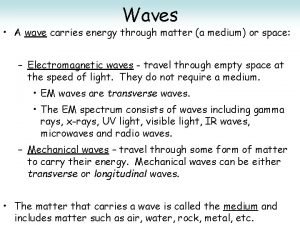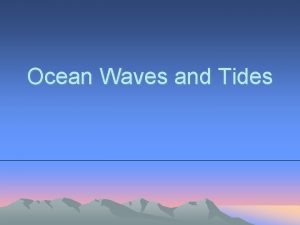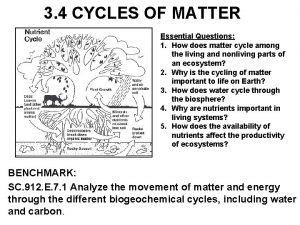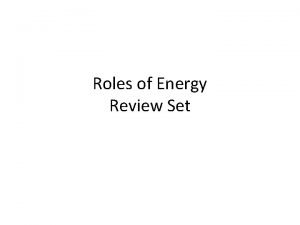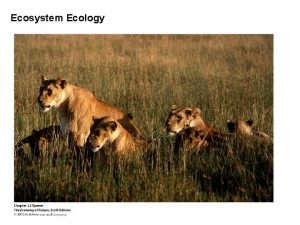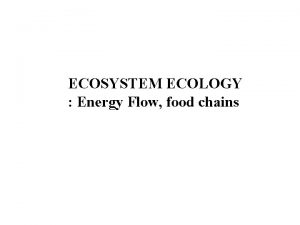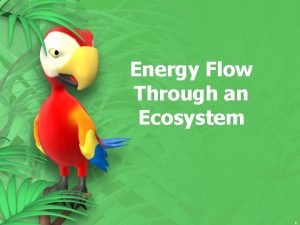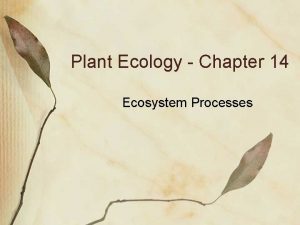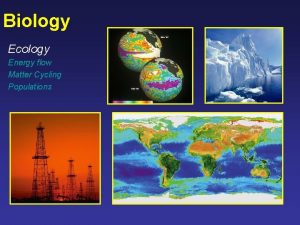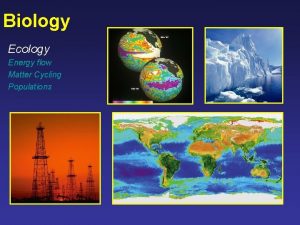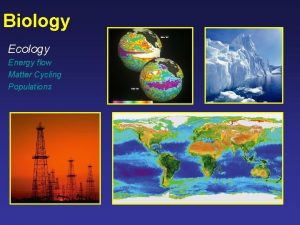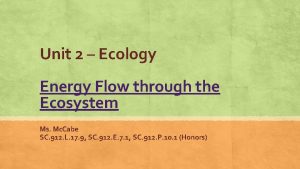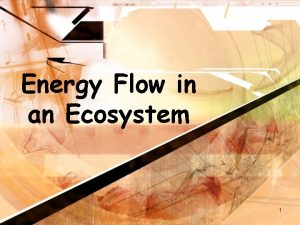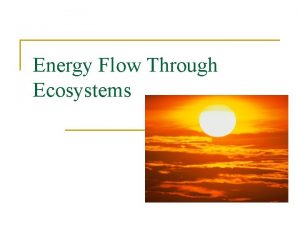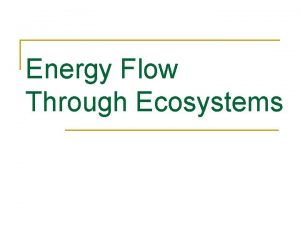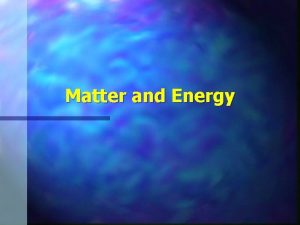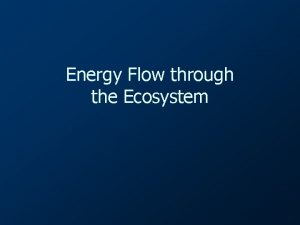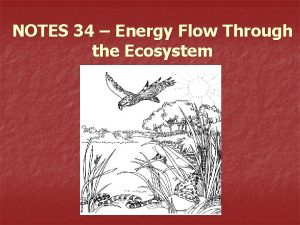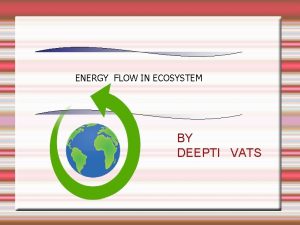Ecology Matter and Energy Flow through an ecosystem








































- Slides: 40

Ecology: Matter and Energy Flow through an ecosystem

Learning Outcomes • BW 8: Students should be able to EXPLAIN how matter and energy flow through ecosystems • No. S 10: Students should be able to APPRECIATE the role of science in society; and its personal, social and global importance; and how society influences scientific research

Matter and Energy Flow • The Sun is the main source of energy on Earth • Provides us with light and heat energy • No Sun = No life on Earth • Solar energy can change into other useful forms of energy e. g. chemical, potential etc.



The flow of matter and energy through ecosystems can be investigated using food chains • A FOOD CHAIN is a sequence of organisms where each ONE IS EATEN BY THE NEXT • Each time an organism is eaten the matter and ENERGY CONTAINED PASSES to the organism that eats it • A food chain shows the PATH OF ENERGY from one living thing to another


Fire flies convert chemical energy in their food back into light energy

EATEN BY

The grass makes its own food and obtains matter from the air, water (minerals) from the soil and energy for the Sun. When the rabbit eats the grass the matter and energy contained in the grass move to the rabbit. When the fox eats the rabbit the matter and energy contained in the rabbit move to the fox

Matter and Energy Flow • PRODUCERS are organisms that MAKE THEIR OWN FOOD using light energy e. g. green plants • CONSUMERS are organisms that OBTAIN THEIR FOOD from other organisms e. g. herbivore, carnivore and omnivores • DECOMPOSERS organisms that feed on DEAD ORGANIC MATTER (plants and animals) allowing for nutrient recycling e. g. fungi and bacteria



Peacock butterfly Fallow deer

Peregrine falcon fastest bird Irish stoat

Pine marten Mistle thrush

Green plant Producer Herbivore Primary Consumer Carnivore Secondary consumer

Worksheet

Predator-Prey Relationship • A predator is an animal that HUNTS AND KILLS another animal for food • Prey are animals that are HUNTED AND KILLED for food • E. g. Clover Slug Thrush Sparrow hawk A thrush hunts and kills (predator) a slug for food (prey). A sparrow hawk hunts and kills (predator) the thrush for food (prey)

Trophic Level (Feeding Level) • This food chain has three trophic levels: 1. The grass is the first feeding level (primary producer) 2. The rabbit is the second feeding level (primary consumer) 3. The fox is the third feeding level (secondary consumer)

Trophic Level (Feeding Level) • A trophic level (feeding level) is the POSITION an organism occupies in a food chain • A food chain starts at trophic level 1 with primary producers such as plants, can move to herbivores at level 2, predators at level 3 and typically finish with carnivores or apex predators at level 4 or 5 • Decomposers make sure that vital elements such as C, Ca and N are recycled

Feeding Level 1 Feeding Level 2 Feeding Level 3 Feeding Level 4


Food Web • A food chain is a simple explanation of producers and consumers, it is more complex in reality When TWO OR MORE FOOD CHAINS ARE INTERCONNECTED a FOOD WEB is formed


How many food chains can you make out of this food web?

Biological processes depend on energy flow through the Earth system https: //www. youtube. com/watch? v=k 6 m. X 5 u. In. Cds

Adaptions • In order to survive, living things adapt to their environment Adaptions are SPECIAL FEATURES which help an organism to survive in their habitat e. g. owls have talons • Primrose produce flower early more light • Butterflies have long tubular mouths reach the nectar • Camels, nettles, seaweed, polar bears, cats, birds, humans …. .


Competition • In any habitat, animals search for space, food, water and partners • Plants are also trying to find light, space, water and minerals from the soil • They are in competition with each other for these resources

Competition • Competition takes place when organisms REQUIRE A RESOURCE IN SHORT SUPPLY, e. g. grass and dandelion competing for light • Occurs between the same species and different species What organisms can you think of that are in competition with each other?

Interdependence • Interdependence occurs because living things DEPEND ON EACH OTHER for survival e. g. plants depend on bees for pollination Ø Ø Rabbits depend on grass for… ? Plants depend on plants for … ? Living things depend on decomposers for … ? Decomposers depend on … ?

TYPE OF INTERDEPENDENCE REASON FOR INTERDEPENDENCE Animals depend on plant Food, shelter, oxygen Animals depend on animals Food, protection Plants depend on animals Pollination, seed dispersal Plants depend on plants Shelter, support Plants and animals depend on decomposers Release chemicals from dead material Decomposers depend on plant and animals Food

Homework • 5 animal/ plant adaptions • 5 animals/ plants in competition with each other • 5 animals/ plants that are interdependent of each other

* Conservation • Conservation is the PRESERVATION AND PROTECTION OF OUR NATURAL HERITAGE (plants and animals) from the damaging effects of human activity • Failure to conserve can result in the death of organisms in their habitats an entire species may even become EXTINCT!

Conservation • Corncrakes are a native Irish bird species in danger of being wiped out in Ireland due to loss of hay meadows in which they breed Ø Extinct Ø Critically endangered (in danger of becoming extinct) Ø Endangered (whose numbers are declining) http: //botanicgardens. ie/wp-content/uploads/2018/06/The-Red-Data. List-of-Irish-Plants-. pdf

Conservation • Conservation is necessary for the following reasons: 1. 2. 3. 4. 5. Prevent extinction of organisms Maintain a balance of nature Plants are a source of many medicines Reduce the risk to human lifestyles Ensure rights of future generations to same natural resources

Conservation https: //www. youtube. com/w atch? v=zl. Kkq. QHCCCs

• The only species on Earth that threatens conservation is humans. It is UP TO US, both as a species and as AN INDIVIDUAL, to support conservation measures. Make yourself aware of issues don’t be blind! Join conservation discussions and groups Support groups and encourage proper conservation Refuse to join in any activity that threatens conservation Ø Refuse to buy products that have been sourced unethically Ø Ø

How can you help conserve the natural world? 1. 2. 3. 4. 5. Government Legislation Nature preserve Reducing invasive species Habitat restoration Captive breeding and sand banks 6. Research 7. Reduce climate change 8. Purchase sustainable products 9. Sustainable living 10. Education https: //greentumble. com/10 -ways-to-conserve-biodiversity/
 Principles of ecology 2 flow of energy in an ecosystem
Principles of ecology 2 flow of energy in an ecosystem How does energy flow through an ecosystem
How does energy flow through an ecosystem Energy transfer in ecosystems
Energy transfer in ecosystems Energy roles in an ecosystem
Energy roles in an ecosystem How does energy flow through an ecosystem
How does energy flow through an ecosystem Energy naturally flows from warmer matter to cooler matter
Energy naturally flows from warmer matter to cooler matter Oikos meaning
Oikos meaning How does matter move
How does matter move Energy flow and material cycling in ecosystem
Energy flow and material cycling in ecosystem Energy flow and material cycling in ecosystem
Energy flow and material cycling in ecosystem Principles of ecology chapter 2
Principles of ecology chapter 2 Principles of ecology section 2 flow of energy
Principles of ecology section 2 flow of energy Simplest path energy takes through an ecosystem
Simplest path energy takes through an ecosystem Difference between ecosystem and ecology
Difference between ecosystem and ecology Difference between ecosystem and ecology
Difference between ecosystem and ecology Ecology and ecosystem
Ecology and ecosystem Chapter 2 section 2 flow of energy in an ecosystem
Chapter 2 section 2 flow of energy in an ecosystem Energy flow in ecosystem
Energy flow in ecosystem Describe the flow of energy in the kelp forest ecosystem
Describe the flow of energy in the kelp forest ecosystem Regents biology food chains and energy in ecosystems
Regents biology food chains and energy in ecosystems Primary and secondary production in ecosystem
Primary and secondary production in ecosystem Ecosystem ecology
Ecosystem ecology Ecosystem ecology
Ecosystem ecology Ecological productivity
Ecological productivity Ecosystem ecology
Ecosystem ecology Ecology ecosystem
Ecology ecosystem Ecosystem ecology
Ecosystem ecology Type of wave
Type of wave Describe the rhythmic movement of a wave
Describe the rhythmic movement of a wave A wave is a disturbance that transmits
A wave is a disturbance that transmits Principles of ecology organisms and their relationships
Principles of ecology organisms and their relationships Chapter 2 principles of ecology answers
Chapter 2 principles of ecology answers 4 cycles of life
4 cycles of life What ecological role best describes grizzly bears?
What ecological role best describes grizzly bears? Koosha golmohammadi
Koosha golmohammadi Cerebral aqueduct
Cerebral aqueduct Gray matter and white matter
Gray matter and white matter What is gray matter in the brain
What is gray matter in the brain Energy energy transfer and general energy analysis
Energy energy transfer and general energy analysis Energy energy transfer and general energy analysis
Energy energy transfer and general energy analysis Tangential sawing of timber
Tangential sawing of timber
